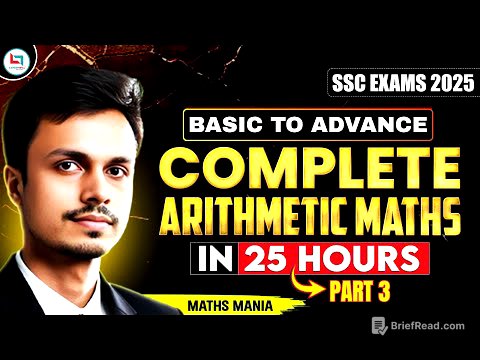TLDR;
This lecture by YAKEEN covers the topic of moving charges and magnetism. It begins with an introduction to the chapter, explaining its four main parts: calculating magnetic fields, determining forces on moving charges, understanding dipoles, and using galvanometers. The lecture then moves into specific concepts such as the Biot-Savart Law, null points, magnetic fields due to circular wires and solenoids, Ampere's Law, magnetic forces on current-carrying wires, magnetic dipoles, and moving coil galvanometers. The importance of understanding direction in solving problems is emphasized, and various rules for determining magnetic field direction are explained.
- Calculating magnetic fields
- Determining forces on moving charges
- Understanding dipoles
- Using galvanometers
Introduction [0:00]
The lecture begins with an energetic introduction, setting the stage for an engaging session on moving charges and magnetism. The instructor outlines the chapter's structure, dividing it into four key parts. First, calculating the magnetic field generated by moving charges. Second, determining the force exerted on moving charges within a magnetic field. Third, understanding the concept of dipoles. Finally, exploring the applications of galvanometers. The instructor emphasizes that prior knowledge isn't necessary, promising to cover everything from the basics.
Biot Salvart Law [17:06]
This section introduces the Biot-Savart Law, which is used to calculate the magnetic field created by a small segment of current-carrying wire. The law is expressed mathematically as dB = (μ₀ / 4π) * (I dL × r) / r³, where dB is the magnetic field, μ₀ is the permeability of free space, I is the current, dL is the length vector of the current element, and r is the distance from the current element to the point where the field is being calculated. The value of μ₀ / 4π is 10⁻⁷ T·m/A. The direction of the magnetic field is determined by the cross product dL × r. The law is then applied to calculate the magnetic field due to a straight wire, with the formula B = (μ₀I / 4πd) * (sin α + sin β), where α and β are the angles from the point to the ends of the wire. For an infinitely long wire, this simplifies to B = μ₀I / 2πd.
Null Point [42:27]
This section discusses how to find a null point, which is a location where the magnetic field is zero due to the opposing fields from two or more current-carrying wires. The formula for finding the null point's distance (x) from one wire is x = (I₁ / (I₁ + I₂)) * d, where I₁ and I₂ are the currents in the wires, and d is the distance between the wires. If the currents are in opposite directions, the null point is found outside the wires, and the formula becomes x = (I₁ / (I₁ - I₂)) * d.
Circular Wire [53:16]
The discussion transitions to magnetic fields generated by circular wires. The magnetic field at the center of a circular loop is given by B = μ₀I / 2r, where r is the radius of the loop. For a coil with N turns, the field is B = Nμ₀I / 2r. If only a portion of the circle is present, the magnetic field is adjusted proportionally by the angle θ: B = (μ₀I / 2r) * (θ / 360). It's noted that when current enters and exits a circular segment, creating a "fata" case, the magnetic field at the center is zero.
Solenoid And Ampere's Law [1:26:49]
Ampere's Law is introduced as a simplified version of Gauss's Law for magnetism, expressed as ∮ B · dl = μ₀I enclosed. This law is applied to calculate the magnetic field inside a solenoid, which is found to be B = μ₀nI, where n is the number of turns per unit length. For a toroid, the magnetic field is B = μ₀NI / 2πr, where r is the average radius of the toroid. It's mentioned that the magnetic field outside an ideal solenoid is zero.
Magnetic Force On Current Carrying Wire [2:49:48]
The lecture explains how to calculate the magnetic force on a current-carrying wire in a magnetic field. The force is given by F = I (L × B), where I is the current, L is the length vector of the wire, and B is the magnetic field. This is often simplified to F = BIL sin θ, where θ is the angle between the wire and the magnetic field. The direction of the force is determined by the right-hand rule. The force per unit length between two parallel wires is F/L = μ₀I₁I₂ / 2πd, where d is the distance between the wires. Parallel currents attract, while anti-parallel currents repel. The definition of an ampere is derived from this force, defining it as the current that produces a force of 2 × 10⁻⁷ N/m between two infinitely long, parallel wires separated by one meter.
Magnetic Dipole [3:45:53]
A current-carrying loop behaves as a magnetic dipole, with a magnetic dipole moment given by m = NIA, where N is the number of turns, I is the current, and A is the area of the loop. The torque on a magnetic dipole in a magnetic field is τ = m × B, which can be written as τ = mB sin θ. The potential energy of a magnetic dipole in a magnetic field is U = -m · B = -mB cos θ. The lecture also covers the relationship between magnetic moment (m) and angular momentum (L), given by m/L = q/2m, where q is the charge and m is the mass of the particle.
Moving Coil Galvanometer [4:04:18]
The final section discusses the moving coil galvanometer, which is a device used to measure small currents. The torque on the coil is balanced by the restoring torque of a spring, leading to the equation NIA B = kθ, where k is the torsion constant of the spring and θ is the angle of deflection. The current sensitivity is defined as θ/I = NAB/k, and the voltage sensitivity is θ/V = NAB/kR, where R is the resistance of the galvanometer. It's noted that the current sensitivity does not depend on the resistance of the galvanometer. The lecture concludes with a discussion of how to convert a galvanometer into an ammeter or a voltmeter by adding shunt resistors in parallel or series, respectively.









